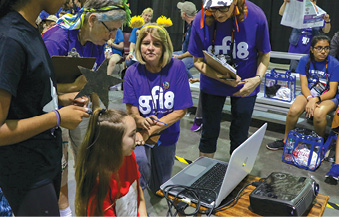Competition Leaves Everything to the Imagination
The aim of the organization is to equip participants with 21st century skills, creative outlets and the confidence needed to succeed in school, career and beyond.
October 1, 2019
Destination Imagination was founded in 1999 and continues to grow with the support of 38,000 volunteers throughout 30 countries. They boast that they have inspired and equipped “more than one million participants” with invaluable 21st century skills, creative outlets and the confidence needed to succeed in school, career and beyond.
The nonprofit has a mission of engaging participants “in project-based challenges that are designed to build confidence and develop extraordinary creativity, critical thinking, communication and teamwork skills.”
Competitions are based on open-ended team challenges that are aimed at evoking the innovative skills and thoughts of students. As Destination Imagination puts it, the challenges “enable students to learn and experience the creative process while fostering their creativity, curiosity and courage.”

The challenges are open to all students worldwide, from kindergarten through university level. Students form teams of up to seven members, select their preferred challenge and work together to develop a solution to the challenge. Each team has at least one team manager (often a parent or teacher) who helps keep the team on track, but does not assist or interfere with the team’s project.
Tina Shaffer is the executive editor and social media director at Destination Imagination. We spoke to Tina to learn more about the competition.
Digital Engineering: Can you provide an overview of your competition, how it came to be and the intent of the program?
Tina Shaffer: Global Finals is the culminating competition for each season of Destination Imagination. Student teams compete in one of six challenge categories (technical, scientific, fine arts, engineering, improv and service learning). Teams first compete at a local level and then at a state level.
DE: Can you tell us about who will be participating? How many participants have you had or are you expecting?
Shaffer: The top-tiered teams from each state and country earn a spot to compete at Global Finals. More than 150,000 kids participate in Destination Imagination each year. This year, we will have 1,200 teams competing at Global Finals 2019. There will be more than 7,000 participants and a total of 17,000 attendees.
DE: Can you tell us about some of the designs that are part of the event and how they came to be?
Shaffer: In our technical challenge, teams designed and build their own aircraft that could take off, land, fly and deliver payloads. For our engineering challenges, teams had to design, build and test their own load-bearing structures that could support large amounts of weight without breaking.
The technical challenge prompts students to complete tasks by using engineering, research, strategic planning and related skills. Students may: Design and build an aircraft that takes off, flies and lands; design the aircraft to deliver a team-created payload; create and present a story about one or more characters exploring a remote place; and create and present two Team Choice Elements that show off the team’s interests, skills, areas of strength and talents.
DE: Are there other components to the competition?
Shaffer: The scientific challenge blends the curiosity of scientific research with the creative expression of performance art. Students may research the human body and medical conditions that affect the human body; create and present a story about a medical mystery that affects a human character; design and build a representation that shows the medical mystery and at least one symptom; and present an action or scene that is shown from two or more perspectives at the same time.
The engineering challenge asks students to design, build and test load-bearing structures created from specific materials. Students may design and build a structure that can support weight without breaking; test the structure by placing weights and then removing them; create and present a story in which the sudden appearance of a monster has surprising results; and design and create a special effect to enhance the sudden appearance of the monster and/or the events surrounding the monster in the story.
Subscribe to our FREE magazine, FREE email newsletters or both!
About the Author
Jim Romeo is a freelance writer based in Chesapeake, VA. Send e-mail about this article to [email protected].
Follow DE





